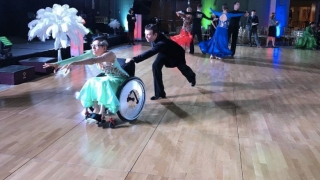GRIN2A-Related Disorders
What are GRIN2A-related disorders?
Pathogenic variants (“mutations”) in the GRIN2A gene cause a spectrum of neurodevelopmental disorders that can include childhood-onset epilepsy, developmental delays, and speech and language disorders. The symptoms a child experiences and the severity of the disorder can vary widely.
GRIN2A is not the name of a medical condition but rather is the name of the gene that is affected. When a disorder is traced back to a pathogenic variant in the GRIN2A gene, it is called a GRIN2A-related disorder.
Signs and symptoms of GRIN2A-related disorders
In many children with GRIN2A-related disorders, delays in achieving developmental milestones during infancy or early childhood, particularly in speech and language domains, may be the first indication of the disorder. In other children, seizures are the first sign of the condition. In most individuals with GRIN2A-related disorders, seizures begin in early childhood, usually between 3 and 6 years of age. However, the age of onset varies widely between individuals, ranging from shortly after birth to later in childhood. Some people with GRIN2A-related disorders never develop epilepsy.
Many children with GRIN2A-related disorders have some degree of developmental delay and cognitive impairment, which ranges in severity from mild to severe. Approximately one-third of children with GRIN2A-related disorders will have age appropriate development.
Epilepsy is a common feature of GRIN2A-related disorders, and it is present in more than 85% of children with this condition. Children with GRIN2A-related disorders may develop different types of seizures, which may be difficult to control with anti-seizure medications. Common seizure types may include:
- Focal seizures with perioral paresthesias (tingling sensation around the mouth)
- Atypical absence seizures
- Focal motor seizures (abnormal movements or jerking of one part of the body)
- Generalized tonic-clonic seizures, also called grand mal seizures (in which the body, arms and legs extend, then contract and shake)
Speech disorders are a characteristic feature of GRIN2A-related disorders, present in more than 90% of individuals. Observed speech disorders fall along a spectrum of severity, which includes dysarthria and speech apraxia, delays and regression in speech and language development, and mild impairment in conversational speech, such as imprecise articulation.
Some children with GRIN2A-related disorders may also have:
- Decreased muscle tone (hypotonia)
- Movement disorders, including ataxia, dystonia or chorea
- Behavior disorders, including aggression, hyperactivity or features of autism spectrum disorder
Diagnosis of GRIN2A-related disorders
Speech and language disorders, particularly speech apraxia, combined with seizures beginning in early childhood may suggest a diagnosis of a GRIN2A-related disorder. However, there are no typical signs of a GRIN2A-related disorder that enable a diagnosis based on clinical features alone.
Genetic testing is required to diagnose a GRIN2A-related disorder.
Additional tests may also be done, including:
- Electroencephalogram (EEG) to look for evidence of abnormal brain activity and seizures
- Magnetic resonance imaging (MRI) to look for changes in brain structure
Some children with GRIN2A-related disorders are also diagnosed with specific epilepsy syndromes based on the types of seizures they have experienced and features of their EEG. Some of these epilepsy syndromes include:
- Benign rolandic epilepsy (also known as childhood epilepsy with centrotemporal spikes)
- Epilepsy with continuous spikes and waves during sleep (CSWS; also called electrical status epilepticus during slow wave sleep or ESES), which is seen in up to one-third of individuals with GRIN2A-related disorders
- Landau-Kleffner syndrome
In these cases, the epilepsy syndrome diagnosis is a description of the types of seizures the child is having, but the genetic diagnosis of GRIN2A-related disorder is the primary diagnosis that explains why a child has developed epilepsy.
Genetics of GRIN2A-related disorders
All children with a GRIN2A-related disorder have a pathogenic variant in the gene GRIN2A, which encodes the instructions to make a protein in the brain that forms a subunit of the NMDA receptor. NMDA receptors are ion channels in the brain that are activated by the neurotransmitter glutamate and that are important for synaptic transmission, learning and memory. When glutamate binds to the NMDA receptor, this activates the ion channel allowing positively charged particles called ions to flow through the membrane of the neuron. The flow of ions through the NMDA receptor, of which GRIN2A is part, is critical to the proper function of neurons. Mutations in GRIN2A impair this process and lead to abnormal functioning of NMDA receptors, resulting in epilepsy and associated developmental differences.
In approximately 50% of children with GRIN2A-related disorders, the pathogenic GRIN2A variant occurred spontaneously (de novo) and was not inherited from either parent. In rare cases, the pathogenic GRIN2A variant has been passed on from an asymptomatic parent due to parental mosaicism. Just like a mosaic piece of art, in which each tile is different, a mosaic parent has distinct cell types. Most cells of a mosaic parent do not carry the pathogenic GRIN2A variant. However, a small proportion of cells do carry the pathogenic GRIN2A variant in very low levels that may be difficult or impossible to detect. In these families where a parent is mosaic, the chance that future siblings may also have a GRIN2A-related disorder may be as high as 50%.
In the remaining 50% of children with GRIN2A-related disorders, the pathogenic GRIN2A variant has been passed on by a parent who may also have a history of epilepsy and a speech disorder. GRIN2A-related disorders do not affect all individuals in the same way, even within the same family. It is therefore not unusual for different family members with the same GRIN2A mutation to experience different clinical symptoms and follow a different clinical course.
Treatment for GRIN2A-related disorders
Treatment for GRIN2A-related disorders will depend on the type and severity of the seizures and associated neurological features.
- A combination of seizure medications is typically used to control the different seizure types. Epilepsy Neurogenetics Initiative (ENGIN) providers have experience in the management of epilepsy in children with GRIN2A-related disorders and can guide optimal medication selection.
- ENGIN providers have been involved in early efforts to develop targeted treatment approaches for GRIN2A-related disorders (Pierson et al. 2014. Ann Clin Trans Neurol)
- A different set of medications, known as “rescue therapies,”may be given to help stop or shorten clusters of seizures when they occur.
- Implantable devices such as vagus nerve stimulation (VNS) or responsive neurostimulation (RNS) may be considered when medications are not effective in controlling seizures.
- Dietary therapy, such as the ketogenic diet, may be helpful in some cases.
Family training and support is a key element in a successful epilepsy treatment plan. Parents and caregivers must know how to watch for and respond to seizures.
Cognitive and developmental delays or autism spectrum disorder associated with GRIN2A-related disorders are treated with physical, occupational and speech therapy, and with the support of early intervention services. Care may be provided by a developmental pediatrician.
Why choose CHOP for treatment of GRIN2A-related seizure disorders?
Families come to our ENGIN Clinic from all over the world. Children with GRIN2A-related disorders who are cared for at Children's Hospital of Philadelphia (CHOP) will receive cutting-edge genetic testing to confirm the underlying cause of their condition, as well as parental testing to confirm the diagnosis and inform recurrence risk with a subsequent pregnancy. Through ENGIN, children have access to any other medical specialists they may need. They also have access to a full range of epilepsy therapies provided through CHOP’s Pediatric Epilepsy Program, including medication, dietary treatment and epilepsy surgery, cutting-edge research, clinical trials, and ongoing follow-up care.
All individuals seen in the ENGIN Clinic are offered the opportunity to participate in research studies related to GRIN2A.
ENGIN integrates genetic testing into the diagnosis and treatment of children with difficult-to-treat or unexplained epilepsies, genetic epilepsy syndromes, and other genetic neurodevelopmental disorders. We combine cutting-edge clinical care and advanced genetic testing with innovative research to identify the underlying cause of a child’s epilepsy and develop an individualized approach to treatment and management.
Resources for GRIN2A-related disorders
CureGRIN Foundation
Simons SearchLight
Beyond the Ion Channel | Dr. Helbig’s Blog for The ILAE Genetics Commission
References
Deletions in 16p13 including GRIN2A in patients with intellectual disability, various dysmorphic features, and seizure disorders of the rolandic region. Reutlinger C, Helbig I, Gawelczyk B, Subero JI, Tönnies H, Muhle H, Finsterwalder K, Vermeer S, Pfundt R, Sperner J, Stefanova I, Gillessen-Kaesbach G, von Spiczak S, van Baalen A, Boor R, Siebert R, Stephani U, Caliebe A. Epilepsia. 51(9):1870-1873.
Mutations in GRIN2A cause idiopathic focal epilepsy with rolandic spikes. Lemke JR, Lal D, Reinthaler EM, Steiner I, Nothnagel M, Alber M, Geider K, Laube B, Schwake M, Finsterwalder K, Franke A, Schilhabel M, Jähn JA, Muhle H, Boor R, Van Paesschen W, Caraballo R, Fejerman N, Weckhuysen S, De Jonghe P, Larsen J, Møller RS, Hjalgrim H, Addis L, Tang S, Hughes E, Pal DK, Veri K, Vaher U, Talvik T, Dimova P, Guerrero López R, Serratosa JM, Linnankivi T, Lehesjoki AE, Ruf S, Wolff M, Buerki S, Wohlrab G, Kroell J, Datta AN, Fiedler B, Kurlemann G, Kluger G, Hahn A, Haberlandt DE, Kutzer C, Sperner J, Becker F, Weber YG, Feucht M, Steinböck H, Neophythou B, Ronen GM, Gruber-Sedlmayr U, Geldner J, Harvey RJ, Hoffmann P, Herms S, Altmüller J, Toliat MR, Thiele H, Nürnberg P, Wilhelm C, Stephani U, Helbig I, Lerche H, Zimprich F, Neubauer BA, Biskup S, von Spiczak S. Nat Genet. 45(9):1067-1072.
Investigation of GRIN2A in common epilepsy phenotypes. Lal D, Steinbrücker S, Schubert J, Sander T, Becker F, Weber Y, Lerche H, Thiele H, Krause R, Lehesjoki AE, Nürnberg P, Palotie A, Neubauer BA, Muhle H, Stephani U, Helbig I, Becker AJ, Schoch S, Hansen J, Dorn T, Hohl C, Lüscher N; Epicure consortium; EuroEPINOMICS-CoGIE consortium, von Spiczak S, Lemke JR. Epilepsy Res. 115:95-99.
GRIN2A mutation and early-onset epileptic encephalopathy: personalized therapy with memantine. Pierson TM, Yuan H, Marsh ED, Fuentes-Fajardo K, Adams DR, Markello T, Golas G, Simeonov DR, Holloman C, Tankovic A, Karamchandani MM, Schreiber JM, Mullikin JC; PhD for the NISC Comparative Sequencing Program, Tifft CJ, Toro C, Boerkoel CF, Traynelis SF, Gahl WA. Ann Clin Transl Neurol. 1(3):190-198.


